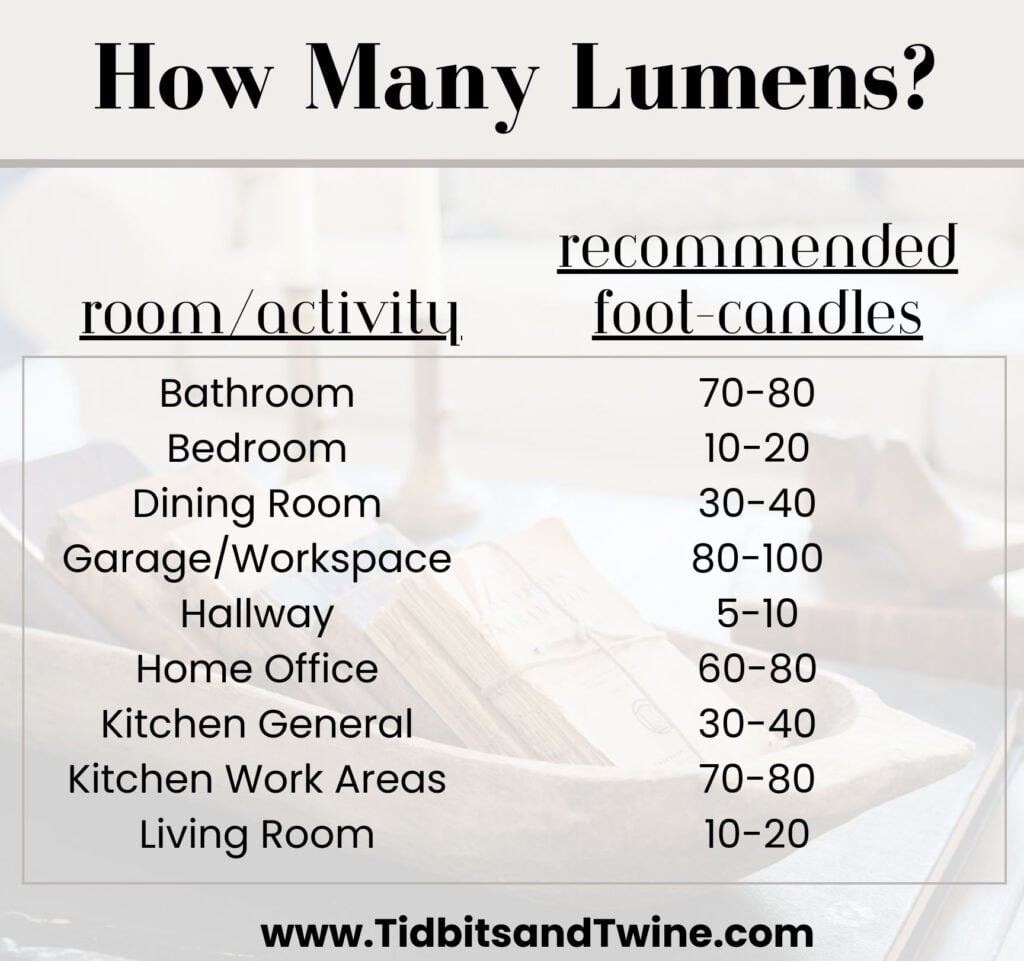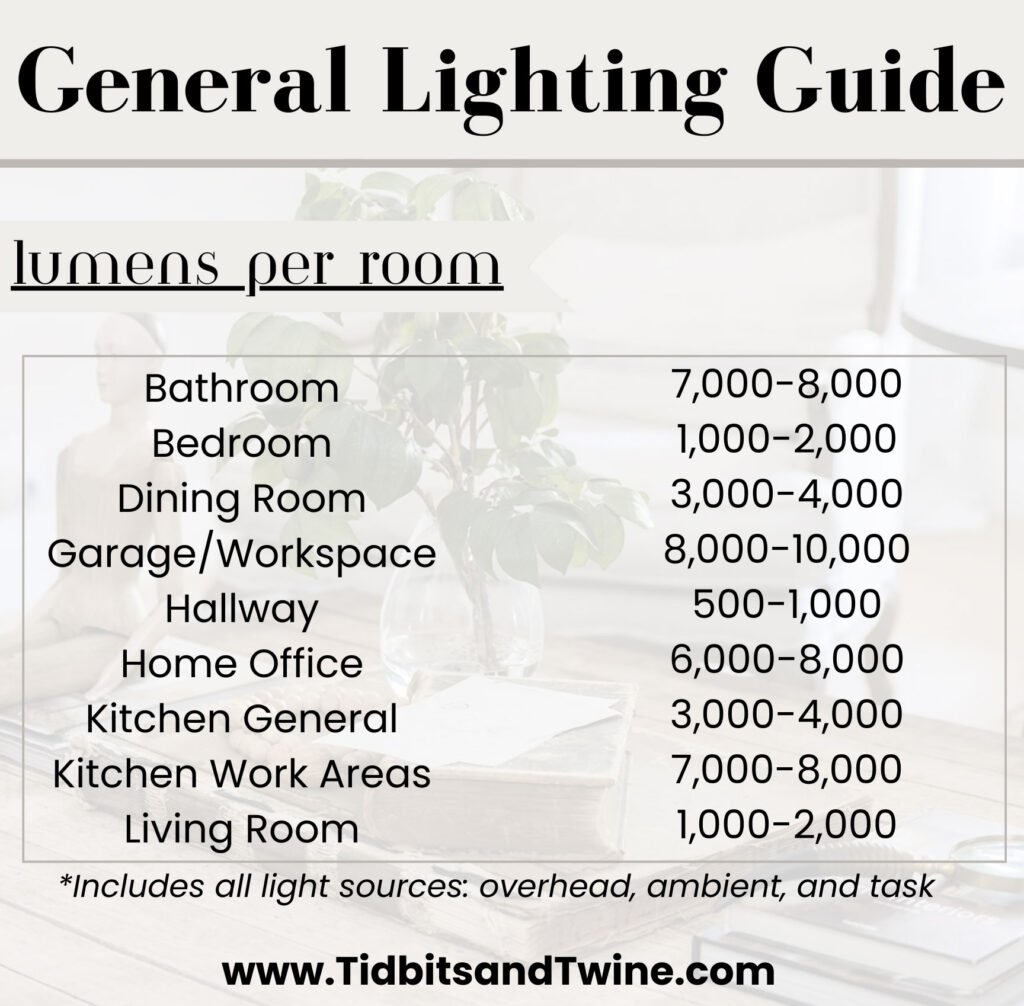Wondering how much light you need for a room? Perhaps you’re wondering what is a Lumen or the difference between a Watt vs Lumen? This guide answers it all!
Let’s continue the trend of writing about subjects you never asked about but might find useful…let’s talk about Lumens! I promise, this article will be il-lumen-ating. Lol!
This article will cover:
In the realm of lighting, Lumens are a crucial metric that are often overlooked but are essential for creating well-lit and comfortable spaces. From the cozy ambiance of the living room to the focused task lighting of the kitchen, understanding Lumens and their recommended levels for each room can significantly impact the overall functionality and aesthetic appeal of your home.
So let’s look at what factors influence how much light a room needs and the optimal light output per room!

I first wrote what I thought would be a dry, but helpful article, comparing light bulb temperatures and how to choose the right color for your home. To my surprise, that article really resonated with readers and I received a lot of feedback about it!

One topic that I didn’t cover in that article was Lumens.
What is a Lumen?
First and foremost, let’s clarify what lumens are and why they matter in lighting design. In simple terms, lumens measure the total amount of visible light emitted by a light source, such as a bulb or fixture. Unlike watts, which measure energy consumption, lumens provide a more accurate representation of the brightness or intensity of light.
The higher the number of lumens, the brighter the light output.
Why Lumens are Important
Once upon a time, we used to measure how bright a light bulb was by looking at Wattage. Now technically, those two things weren’t related, but with incandescent bulbs, the higher the wattage, the brighter the light. No one ever even mentioned the word Lumens! You just knew that a 60W bulb would be brighter than a 25W bulb and so on.
Easy peasy…and then came LED bulbs.
LED bulbs are much more energy efficient than traditional incandescent light bulbs. So much so, in fact, that my state of California has completely banned incandescent bulbs! We litterally can’t buy them in store or online!
LED bulbs are significantly more energy-efficient than incandescent bulbs. LEDs convert a higher percentage of electricity into light, whereas incandescent bulbs produce a significant amount of heat, resulting in wasted energy.
What this means is that a low Watt LED bulb might actually be brighter than a higher Watt incandescent bulb. And so, Watts are no longer a good indicator of light output!

Difference between Lumen vs Watts
Understanding the distinction between lumens and watts is fundamental when it comes to choosing lighting for your home.
Watts measure the amount of power consumed by a light bulb, indicating its energy consumption rather than its brightness.
On the other hand, lumens quantify the amount of visible light emitted by a light source, providing a more accurate measure of brightness.

How to Calculate Lumens
The formula for calculating how many lumens are needed in a room depends on several factors, including the room’s size, purpose, and desired lighting level. However, a general guideline often used is:
Lumens Formula
Lumens = Room’s Length x Room’s Width x Foot-candles
I know. Now you’re thinking “What the heck is a foot-candle?” Don’t worry about it! I’ve made. a handy chart for the home so all you need to figure out is the size of your room!
Example: Let’s say your living room is 10 ft long by 8 ft wide. Using the chart below:
10ft x 8ft x 10 foot-candles = 800 Lumens Minimum

Lumen Recommendations by Room
Okay, so maybe you don’t want to measure your room and want an easy rule-of-thumb for how much light you need in each room.
Lumens Guide
In general:
- Low light areas need about 10-20 lumens per square foot.
- Task areas require 70-80 lumens per square foot.
- Living Room: As the central gathering space for relaxation and entertainment, the living room benefits from a combination of ambient, task, and accent lighting. Aim for approximately 1,000 to 2,000 lumens to create a warm and inviting atmosphere conducive to socializing and relaxation.
- Kitchen: The kitchen is a multifunctional space that requires ample illumination for cooking, food preparation, and dining. Aim for approximately 3,000 to 8,000 lumens, with focused task lighting over work surfaces and ambient lighting in dining areas to ensure optimal visibility and functionality.
- Bedroom: In the bedroom, where relaxation and comfort are paramount, opt for softer, dimmable lighting to create a cozy ambiance. Aim for approximately 1,000 to 2,000 lumens, with adjustable fixtures that allow for customized lighting levels depending on the time of day and activities.
- Bathroom: Proper lighting in the bathroom is essential for grooming tasks such as shaving and applying makeup. Aim for approximately 7,000 to 8,000 lumens, with bright, even lighting around the vanity area and softer, ambient lighting throughout the rest of the space.
- Home Office: In the home office, where productivity is key, prioritize bright, focused lighting to reduce eye strain and enhance concentration. Aim for approximately 6,000 to 8,000 lumens, with task lighting directed at the work surface and ambient lighting to reduce glare and create a comfortable working environment.
- Dining Room: The dining room is an area where ambiance is paramount, making dimmable lighting an ideal choice. Aim for approximately 3,000 to 4,000 lumens, with adjustable fixtures that allow for flexibility in lighting levels depending on the occasion and desired mood.

What Affects How Many Lumens are Needed
Several factors influence the illumination needs of each room in your home, including:
- Room Size: Larger rooms generally require higher lumen levels to adequately illuminate the space and prevent dark corners or shadows.
- Functionality: The intended use of the room also plays a significant role in determining illumination needs. For example, task-oriented spaces like kitchens and home offices require brighter, more focused lighting, while areas designated for relaxation, such as bedrooms and living rooms, benefit from softer, ambient lighting.
- Ambiance: The desired ambiance or mood of the room can influence the choice of lighting and lumen levels. Warm, dimmable lighting creates a cozy atmosphere in bedrooms and dining rooms, while bright, cool-toned lighting enhances productivity in workspaces.
- Ceiling Height – The taller your ceilings, the more light you might need to illuminate the space as the light source will be further area from the floor.
Use Dimmer Switches
I’m a huge fan of dimmer switches because they allow you to adjust how much light is in a given room. For example, you might want your kitchen to be bright when cooking, but maybe at night you’d like it to have just an ambient glow.
When possible, also install a dimmer switch for overhead lights! They can’t increase your Lumens above what you’ve purchased, but they allow you to decrease light to adjust for various needs.
Don’t Forget About Your Light Color
If you are’t familiar with light colors (temperatures), check out my color guide here.
More Decorating Guides
- Soft White vs Daylight Bulbs And which to Choose
- Need to Know Bathroom Measurements
- Design Guide: The Right Wall Sconce Height for Every Room

Join the Community
Let’s keep in touch! Get exclusive artwork plus the latest news delivered directly to your Inbox!

